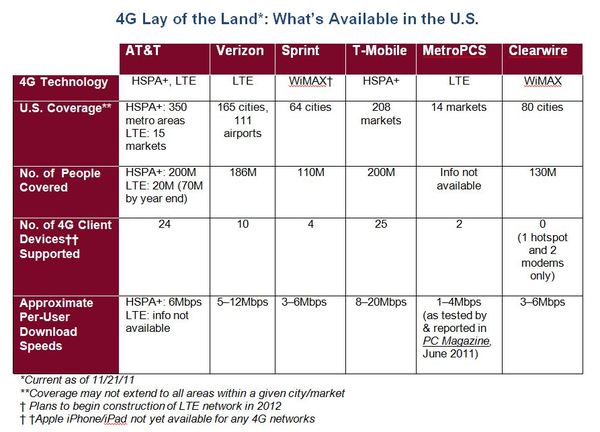- A TechNote on Wireless and Mobility
- Joanie M. Wexler
- Technology Analyst/Editor
- Editorial Director, TechNotes
And it's not just about keeping up with the Joneses: According to a late-October survey conducted by research firm In-Stat, 75% of more than 1,200 respondents cited "4G" as a feature they would like to see in their "ideal" mobile phone, along with touchscreens, email, camera, speakerphone and GPS.
In this spirit - and in a scramble to overtake its biggest 4G rival Verizon Wireless - AT&T last week launched Long Term Evolution (LTE) service in six additional markets. The move brought the carrier's 4G service coverage to 15 U.S. markets (see chart for service comparisons).
AT&T also announced availability of the Android 3.2-based Samsung Galaxy Tab 8.9, which became available for its LTE network last Sunday. The other LTE-enabled 4G tablet AT&T offers is the HTC Jetstream, which runs Android 3.1.
As for 4G smart phones, the carrier offers the HTC Vivid and the Galaxy S II Skyrocket, which both run Android 2.3.
Double Your Data, Double Your Fun
Meantime, Verizon Wireless earlier this month made available three new smart phones for its 11-month-old LTE network: the Droid RAZR, the HTC Rezound and the Samsung Galaxy Nexus, which are all Android devices. Verizon Wireless also offers two LTE-compatible Android-based tablets: the Motorola Xoom and the Samsung Galaxy Tab 10.1.
And - in order to free up its EV-DO 3G spectrum for more iPhone traffic - the carrier is now offering new and existing 4G smart phone customers double their usual data-cap allotment for the same price. For example, if you pay $30 a month for 2GB of data, you suddenly get 4GB. Verizon said that once you sign up for the double-cap plan, it will remain in effect for the life of your 4G smart phone.
For its part, T-Mobile USA announced in mid-November that it has doubled the speed of its 4G network in 11 additional markets, using its HSPA+ 42 technology. The carrier also expanded the reach of its lower-speed, nationwide HSPA+ 21 network to nine additional markets.
Note that there are still no Apple iPhones or iPads available for any of the 4G networks. However, the latest iPhone, the 4S, now runs on AT&T, Verizon and Sprint 3G mobile WANs.
What Is 4G, Anyway?
 "4G" has morphed into a casual name for any mobile WAN that runs at approximately 1Mbps per user or higher, though speeds can range anywhere up to 20Mbps (refer to chart).
"4G" has morphed into a casual name for any mobile WAN that runs at approximately 1Mbps per user or higher, though speeds can range anywhere up to 20Mbps (refer to chart). In fact, although the In-Stat survey showed that 4G is an important handset feature, analyst Greg Potter reports "a lot of confusion surrounding 4G. When asked which carrier offered the fastest 4G speeds, the majority didn't know or felt they were the same across carriers."
Officially, there is a standards-based definition of "4G," specified by the International Telecommunications Union-Radiocommunications sector (ITU-R). It calls for peak speeds of 100Mbps for high-mobility apps (such as from trains and cars) and 1Gbps for low-mobility situations, such as unplugged stationary users.
The ITU-R approved two 4G standards-based technologies that match these requirements: LTE Advanced and WirelessMAN-Advanced. Though these services currently are nowhere in sight, Sprint has said it will begin building its own LTE network next year - leaving the fate of its own WiMAX services and those of partner Clearwire a question mark - and that it expects to start delivering LTE Advanced in 2013.
What's to Become of WiMAX?
The prognosis for WiMAX in North America is sobering, what with Clearwire going broke, Sprint being noncommittal to its future, and one-time big shot WiMAX groupies, like Intel, turning their backs on the technology.
Worldwide, however, it's a different story. WiMAX networks from various operators cover more than 823 million people in approximately 149 countries, and the WiMAX Forum expects the networks to reach one billion people by year's end. The networks currently serve about 20 million paying subscribers.
And despite LTE emerging as the 4G big cheese in North America, globally, LTE runs on over a dozen frequency bands in the world, making it difficult to become a global standard for roaming. WiMAX, on the other hand, operates primarily in three global bands. As such, it might have a better shot as an international service for worldwide travelers.













Great article Joanie. So useful to have this all in one place. You said "Motorola also offers two LTE-compatible Android-based tablets: the Motorola Xoom and the Samsung Galaxy Tab 10.1." -- I think you meant VzW also offers?
Also, I find it interesting that carriers like VzW need to resort to promotions to push subscribers onto 4G in order to free up 3G capacity. Customers will flock to 4G as they upgrade their devices - just as they did when 3G emerged. It's hard for consumers to justify paying more for something they aren't sure they need and only have spotty access to. But watch what happens if the iPad3 and iPhone5 come out with 4G...